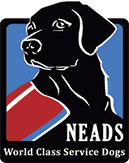Rules for a Reason
When you attend your intensive client training period at NEADS, the trainers spend a lot of time going over what the dogs currently understand as rules, what they have been expected to do (or not to do) throughout their puppyhood and finally how you are expected to continue their training. Assuming responsibility for a specially trained Service Dog that has taken over a year of focused training, attention, medical care and monetary investment can be intimidating for some people. But the value associated with such responsibility is immeasurable.
As trainers, we are invested in you and your dog as a team. We want you and your dog to be successful, happy, and healthy. We care deeply for what we do, and in a sense become a sort of parental figure for the two of you. If you are a parent yourself, you are familiar with the fervent feelings of worry, nurture, structure and pride. We are too.
Because we care, we set guidelines that we expect you to follow in order to keep your team in optimal working condition. Here are a couple of key “NEADS rules” and why they are important to follow:
Continue to use all of the equipment your team was certified with
NEADS dogs are trained and certified while wearing the Gentle Leader. This head halter is designed to reduce pulling and give you more control over the dog’s head/nose (the trouble making end). We have tried other products in the past but with much less success. If you or your dog is having difficulty using the Gentle Leader, please contact your trainer for advice.
NEADS also supplies each client team with a cape/vest and/or backpack. These serve to identify your dog as a working dog in public and also to provide some small carrying capacity. According to Assistance Dogs International, all dogs that are certified with an accredited organization (NEADS is proudly accredited by ADI) must be visibly identified with the training school’s name.
The other reason to keep your dog safely on lead is one that many people overlook. No recall (“come” command) is EVER 100% reliable. Although we spend a lot of time training our dogs to “come” on cue, there is no guarantee that a dog will always make the choice we want them to make when presented with a tough decision. For example, if you take your dog to the beach and set them loose, they are bound to find all kinds of interesting things to sniff, eat and roll in. Would it be worth it to your dog to drop a dead crab, ignore running seagulls and resist the urge to dig in the sand as soon as you say the word “come”? It’s hard to say. Without a leash to reinforce your command, there is a very good chance that your dog will begin to understand that your words are suggestions rather than commands.

